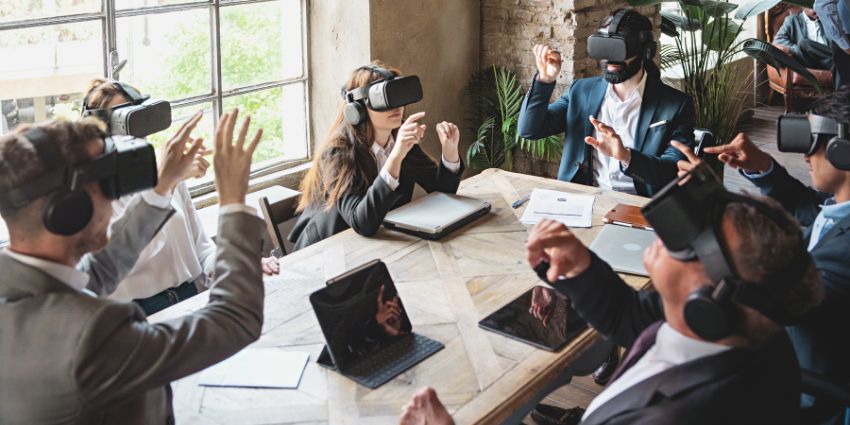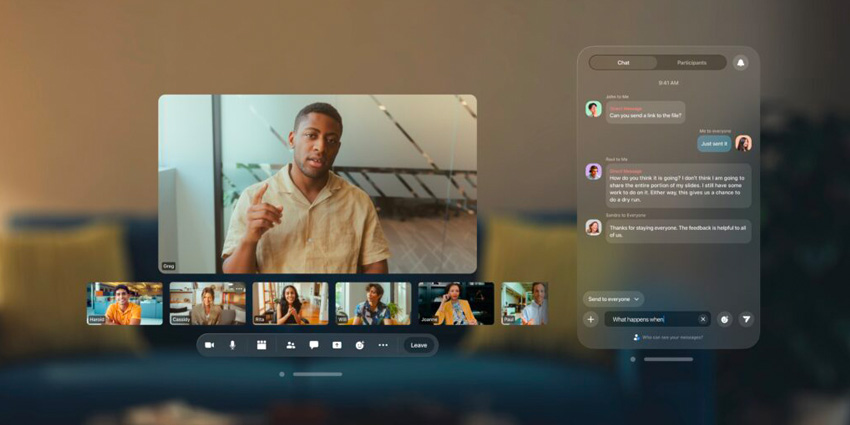Collaboration has always been essential to a successful workplace. When teams can work cohesively together, they’re more creative, productive, and efficient. However, the way we collaborate has changed somewhat in recent years. With teams now operating in distributed landscapes, thanks to the rise of hybrid and remote work, face-to-face interactions are becoming less common.
Though collaboration platforms like Microsoft Teams and Zoom, as well as video conferencing tools have paved the way for new forms of digital collaboration, these tools can sometimes fail to deliver the right results in certain areas. For instance, they can struggle to deliver a fully engaging, inclusive experience to all staff members. That’s where immersive collaboration comes in.
Immersive collaboration technology allows companies to recreate the workplace for team members, using XR hardware and software, metaverse spaces and digital twins, and even artificial intelligence. Here are the main reasons why companies should consider investing in immersive collaboration technology for 2023 and beyond.
1. Improved Inclusivity for All Types of Workers
The rapid rise of remote work has created some challenges for business leaders. Although companies are taking steps to ensure their staff have the right tools and resources to stay productive when working flexibly, many remote staff members often feel isolated from the rest of the business. Studies have even shown remote employees are often overlooked by managers and leaders.
In a time of severe talent shortages, companies need to ensure they can create a diverse, inclusive environment, which engages remote team members as much as in-office workers. Taking steps to ensure every employee feels connected to the rest of the workforce improves engagement levels among teams, and enhances productivity, paving the way for better business results.
With XR, companies can recreate the sense of “presence” required in the modern world, to help reconnect distributed workers. In virtual reality, every team member can share the same virtual space during conversations. With AR and MR tools, companies can transport remote employees into real-world environments. This helps to strengthen employee experiences and company culture.
2. Higher Levels of Productivity
Excellent collaboration has a direct impact on productivity. However, it’s often difficult for teams to thrive if they don’t have access to the right information and resources. Extended Reality can solve this problem, by allowing companies to create environments where all staff members, regardless of their location, can access the same contextual resources and data.
An AR or MR solution can allow businesses to deliver three-dimensional guidelines and information to team members in real-time, when they’re working in the field, or at home. This ensures staff can access the data they need without having to juggle manuals and countless documents. AR solutions can even allow back-end employees to annotate real-life situations instantly, providing step-by-step guidance when team members need support, and reducing bottlenecks.
In virtual reality, companies can create digital twins of products and environments, to ensure every employee has all of the tools they need to work cohesively as a team. With AI tools built into the XR environment, companies can even provide their staff members with virtual assistants to help them surface information faster, and complete tasks more efficiently.
3. Greater Creativity and Ideation
Extended Reality has the power to unlock our true creative potential, by eliminating the restrictions of the real world. In a virtual reality environment, for instance, teams can work together on the creation of a new product, without having to worry about space restrictions, or wasting valuable materials and resources. They can experiment with different ideas, analyse how solutions might work, and collect and share valuable data in real time to make product development faster.
Already, leading companies around the world have begun implementing XR solutions and digital twins into the production process, giving teams more freedom to experiment with their ideas in an ever-scalable environment. Extended Reality also provides teams with low-risk ways of experimenting with different types of collaboration, to see which options boost engagement.
Teams can take part in gamified experiences, and even leverage integrations with other valuable productivity and development tools, all while sharing the same environment. Many of the top applications for immersive work allow rapid integration with everything from tools like Microsoft Teams, to file sharing apps, and CAD platforms.
4. Opportunities for Collaborative Learning
As skills gaps continue to proliferate the modern world, companies need to invest in consistently upskilling and reskilling employees. However, this doesn’t always have to mean producing step-by-step tutorials or investing in face-to-face training sessions. With Immersive collaboration tools, companies can pave the way for peer-to-peer knowledge sharing and group learning.
Collaborative tools give teams an opportunity to learn how to work together, developing soft skills such as leadership and communication abilities during gamified environments. At the same time, these environments also pave the way for the rapid sharing of knowledge in various environments. With AR and MR solutions, subject matter experts can provide real-time guidance and instruction to employees wherever they are, helping them to become more efficient in their roles.
With virtual reality solutions, team members can upload information directly into their virtual landscape, create presentations, and walk through ideas with staff members. Studies have already shown that XR has a powerful impact on learning outcomes, with PWC reporting that learners in VR complete training around 4 times faster than their peers.
5. Reduced Costs and Carbon Footprint
While implementing immersive collaboration into the workplace does require some upfront investment, it can save companies a significant amount of money and time in the long-term. First, empowering staff with immersive collaboration tools reduces the need for travel, minimising the carbon footprint of the business, and eliminating unnecessary transportation costs.
Secondly, because teams using immersive collaboration tools can experiment with materials and resources in a virtual world, without wasting any equipment, companies don’t have to spend as much on developing products and ideas in the first place. XR gives teams a low-risk way to experiment with different products, without wasting resources.
What’s more, immersive technology in the collaborative world can make teams more efficient, helping them to complete tasks faster, so projects can be taken to market at speed. With access to guidance and resources in a virtual world, teams are less likely to make mistakes, and may produce better results at a quicker rate.
6. Attracting and Retaining Talent
Finally, as mentioned above, many of today’s companies are suffering with significant skill shortages. It’s becoming increasingly difficult for business leaders to find the professionals they need, and keep them engaged within the workplace. Investing in XR collaboration tools can help with this.
Immersive collaboration tools can highlight a company’s commitment to investing in the latest technology to empower their workers. This makes the business more attractive to a wider range of distributed professionals. Additionally, the same solutions can enhance the onboarding experience, helping staff members to get to know their teams, and immerse themselves in the company culture.
Immersive collaboration solutions can even improve employee retention, by helping staff members to form deeper relationships in new environments, and keeping staff engaged. Businesses can even leverage gamification strategies, to facilitate healthy competition in the workplace, improve team bonding exercises, and reduce the risk of disputes between staff.







